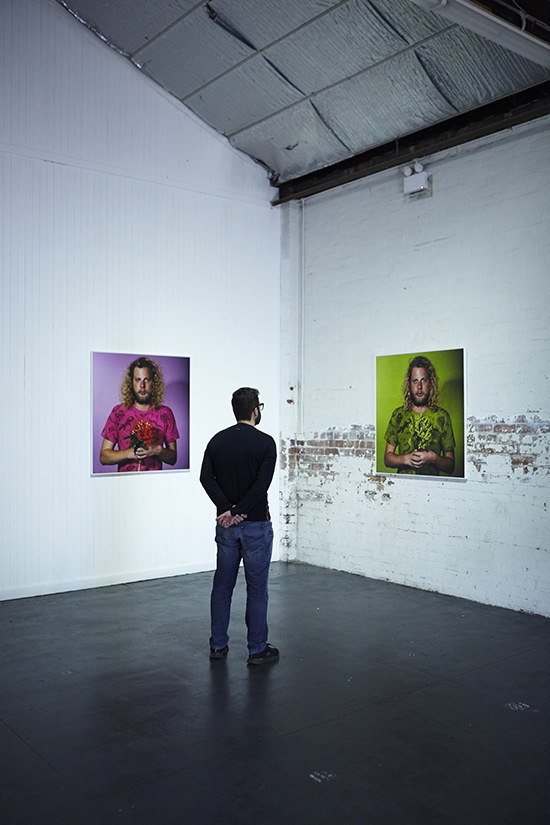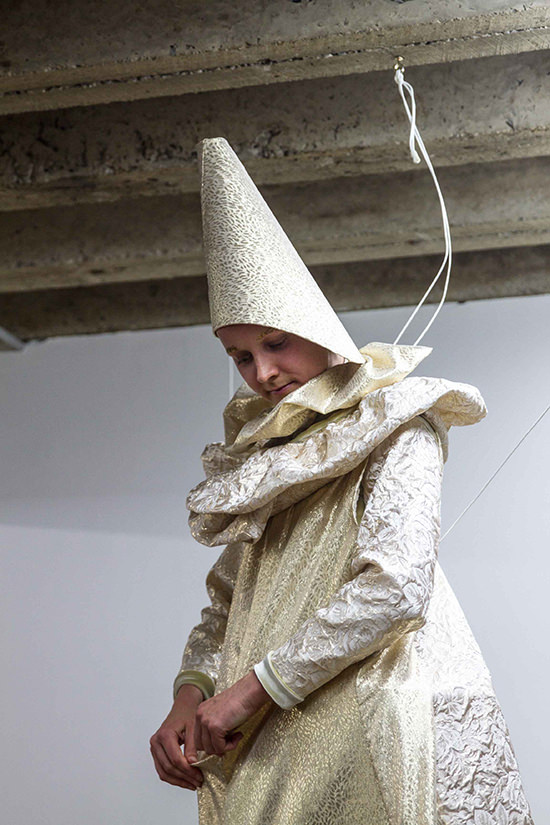Next Wave Festival: complex selves & cultures
Catherine Clover: four visual art exhibitions

Abdul-Rahman Abdullah, Monster Maker, 2016, painted wood, image courtesy the artist and This Is No Fantasy + Dianne Tanzer Gallery, The Fraud Complex, Next Wave 2016
Four Next Wave Festival exhibitions keenly illustrate contemporary preoccupations with identity, both cultural and sexual. It is exciting to witness both issues squarely at the forefront of artists’ and curators’ creative concerns with individual artists questioning the past and present and making propositions about the future. With a commitment to a new generation of artists who explore diversity and inclusion, these exhibitions are solid examples of the festival’s concerns.

Something Less exhibition
photo Kieren Seymour
Something Less exhibition
Alasdair Doyle & Liam James, Something Less
In Something Less at The Stables, part of the Meat Market complex, Liam James personalises his quest for cultural and sexual identity using performative strategies with lens-based media to create an intimacy that is both compelling and unnerving. Through still and moving images we see James foregrounded, pale-skinned and blonde, staring straight at the camera. In the series of still photographs we see a young man holding flowers and in the video James is a red-eyed young man in a dress. In a detailed replication of the setting of Tracey Moffatt’s seminal photographic image Something More #1 (1989) James places himself in the foreground. The video—and the title of the exhibition—is something of an homage. Unfortunately, the sound is played too loud, the hard acoustics of the room making this a tough, if not impossible, listening experience. In both works, Liam James presents a sensitive questioning of self, yet an insistent and unabashed one. By demanding our attention in this way, associations with our narcissistic selfie era are hard to avoid.
James’ works are installed in two gallery spaces, separated by a third connecting space which is the setting for the book Where Contradictions Collide by Alasdair Doyle. This gallery contains two videos and a hard copy of the book. One video documents Skype discussions concerning the content and, in the second, the book is silently leafed through with white-gloved hands, suggesting a preciousness towards the material. Full of information and critique concerning Tasmanian Indigenous experience from writers and artists of various generations, the text is a rich resource.

Something Less exhibition
photo Zan Wimberley
Something Less exhibition
Sharing the physical space rather than collaborating as such, Doyle’s text operates as a conduit between his own and James’ works and places an emphasis on the textual component over the visual works. The mixing of the visual art works with text and publication is topical given the large number of practice-led PhDs that artists are undertaking these days, but achieving an equality between the two forms requires a delicate balance.
The Fraud Complex, curators Johnson+Thwaites
Fraud, fake, fake it till you make it, deceit, imitation, feeling like a fake in our lives; the imposter syndrome is a common experience for many of us these days. The title of The Fraud Complex can be read as both a psychological state and a pun on Freud’s name, particularly as the Westspace opening was held on Sigmund’s birthday (6 May). On entering the gallery the viewer is faced with a large mirror by Hany Armanious (Body Swap). With psychoanalysis in mind it is hard not to read this literally as Lacan’s mirror stage, which initiates a world of perception rather than of imagination. A fitting start to a curatorial premise that questions what appears to be one thing but could easily be another.
Perception is what is at play in this exhibition and Técha Noble, Casey Legler and Jordan Graham’s captivating video That Self is a good example of how gender can seem to be in flux, an immersive embodiment of Judith Butler’s concept of gender as performativity. What amounts to an accusation of cultural fraud is the raison d’être of Bindi Cole’s chillingly witty series of digital prints, Not Really Aboriginal, portraits of herself and her fair-skinned family wearing blackface, while Megan Cope’s ironic Discover your Aboriginality offers a counter to Cole’s series by giving visitors the chance to experience something of how it feels to be Aboriginal. The artwork is presented as a written test that can be taken and submitted on the spot to see if visitors have been, as Cope puts it, “touched with the tar brush.”

The Fraud Complex exhibition
photo Alan Weedon
The Fraud Complex exhibition
Johnson+Thwaites’ curatorial choices are mostly effective with a robust mix of established and emerging artists. The works explore a number of possible frauds including sexual (Tyza Stewart’s Self-Portrait), cultural (Yoshua Okón’s The Indian Project) and art (Artsheaven.com’s painting-8598 Guernica and painting-9752 Composition with Red, Yellow and Blue) with varying degrees of success. Humour, at times very dark, is put to good use in most of the works, easing the show’s unevenness. Guided by the trickster, the wag, the Australian larrikin, the viewer wonders what is real and what is not, what is fiction and what is fact. Nothing is clear as boundaries blur and reference points vanish. With the impossibility of perceiving a single truth, the curators seem to be concurring with historian Hayden White’s assertion that fiction is more real than fact (“Historical Fiction, Fictional History and Historical Reality,” in Rethinking History 9, vol 2-3, 2005).
Katie West, Decolonist
Katie West’s Decolonist, also at Westspace, is a meditation exercise where the visitor is guided through a process through which to unlearn the impact of colonisation or, as the narrator describes it, to decolonise. “When we meditate we decolonise our bodies,” suggests a female voice gently and persuasively. I hesitate at first but as I sit on the wide Westspace window sill covered in crushed eucalyptus leaves the pungency is seductive and I stay put. The narrator continues: “this is a space to sit still” and I do as I am told.
The video is of a eucalypt forest rendered in purple-ish monochrome. In the centre are two overlapping circles with the overlap shaded in. West describes this intersection as “a space where both western and indigenous philosophical traditions inform our social norms and values” (“My art is a personal antidote for the effects of colonisation,” The Guardian). Ephemeral in its realisation, with the room dim, the video is projected on thin muslin which moves with the passage of air through the gallery, echoing the natural cycles that the meditation exercise promotes.
As a young Yindjibarndi woman based in Perth, Katie West is offering non-Aboriginal Australians a means to recognise our collective responsibility through this meditative process. This gesture, generous in intent and representative of her people, is the core strength of the exhibition. As an installation it seems to be a work in development, but it engages with a refreshing lightness of touch with an issue that bears heavily on contemporary Australian society.

Ua numi le fau exhibition
photo Zan Wimberley
Ua numi le fau exhibition
Ua Numi Le Fau, curated by Léuli Eshraghi
At Gertrude Contemporary, a range of disciplines and media are represented in Ua Numi Le Fau that identify the wider setting as Narrm, the great bay, where the settler colonial city of Melbourne is built. The curation of the exhibition by Léuli Eshraghi emphasises indigeneity as the way of knowing that links artists, artworks and site, “binding time and space for brighter days to come.” The curation is well handled and tight, using the two gallery spaces thoughtfully, allowing well-chosen works space to breathe individually but also to make connections.
The exhibition is entered through Megan Cope and Robbie Thorpe’s Makin’ Waves, a transparent mapping work on the gallery window that turns the bay of Narrm literally upside down. In the front gallery Mandy Nicholson’s abstract painting honours Wurundjeri artist and 19th century cultural spokesman William Barak. A bright sunny Saturday afternoon almost completely bleaches out Frédéric Nauczyciel’s experimental videos that blend dance with cinematic interests, and makes for difficult viewing. So too Carlos Motta’s two videos of unknown stories of the colonisation of Colombia in the main gallery are surprisingly washed out and make immersion in the content a struggle.

Ua numi le fau exhibition
photo Zan Wimberley
Ua numi le fau exhibition
Yuki Kihara’s monochromatic photographs address issues that face contemporary S?moa. The images are of an anonymous female character in a hooped Victorian dress, back turned to the camera, in nuanced settings that range from the more covert construction of nature to the overt construction of culture. The anonymity of this woman contrasts with Atong Atem’s brightly coloured and highly patterned photographic portraits of groups of women from the African diaspora of Melbourne staring confidently out of the picture’s frame.
Three embroidered works by Bidjara, Ghungalu and Garingbal peoples artist Dale Harding explore the untold histories of his communities. Including stereotypical symbols of Australian identity such as the kangaroo, cockatoo and xanthorrhoea, known pejoratively as ‘the black boy,’ and visually referencing a pixelating retro online game with his technique, Harding embraces a form historically considered a domestic craft for women. Humble in their realisation the works are full of a wicked and sassy humour around identity and the body.

Léuli Eshraghi, Ua numi le fau curator
photo Lisa White
Léuli Eshraghi, Ua numi le fau curator
Next Wave Festival 2016: Something Less, Alasdair Doyle and Liam James, The Stables, Meat Market, 13-22 May; The Fraud Complex, curated by Johnson+Thwaites, Westspace, 6 May-4 June; Decolonist, Katie West, Westspace, 6 May- 4 June; Ua numi le fau, curator Léuli Eshraghi, Gertrude Contemporary, Melbourne, 6 May-25 June
RealTime issue #133 June-July 2016






